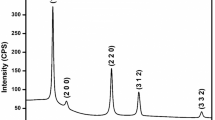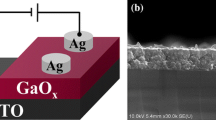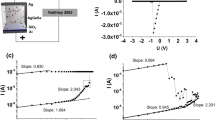Abstract
A selector device that demonstrates high nonlinearity and low switching voltages was fabricated using HfOx as a solid electrolyte doped with Ag electrodes. The electronic conductance of the volatile conductive filaments responsible for the switching was studied under both static and dynamic conditions. A compact model is developed from this study that describes the physical processes of the formation and rupture of the Ag filament(s). A dynamic capacitance model is used to fit the transient current traces under different voltage bias, which enables the extraction of parameters associated with the various parasitic components in the device.






Similar content being viewed by others
References
L.O. Chua, Memristor-the missing circuit element. Circuit Theory IEEE Trans. 18(5), 507–519 (1971)
D.B. Strukov et al., The missing memristor found. Nature 453(7191), 80–83 (2008)
G.A. Gibson et al., An accurate locally active memristor model for S-type negative differential resistance in NbOx. Appl. Phys. Lett. 108(2), 023505 (2016)
G.W. Burr et al., Access devices for 3D crosspoint memory a. J. Vac. Sci. B Technol. Nanotechnol. Microelectron. 32(4),040802 (2014)
J.J. Yang, D.B. Strukov, D.R. Stewart, Memristive devices for computing. Nature Nanotechnol. 8(1), 13–24 (2013)
B.J. Choi et al., Trilayer tunnel selectors for memristor memory cells. Adv. Mater. 28(2), 356–362 (2016)
W.G. Kim et al., NbO 2-based low power and cost effective 1S1R switching for high density cross point ReRAM Application. In: 2014 symposium on VLSI technology (VLSI-Technology): digest of technical papers. 2014
Kim, S., et al. Ultrathin (< 10 nm) Nb 2 O 5/NbO 2 hybrid memory with both memory and selector characteristics for high density 3D vertically stackable RRAM applications. in VLSI technology (VLSIT), 2012 symposium on. 2012. IEEE
G. Burr et al., Large-scale (512kbit) integration of multilayer-ready access-devices based on mixed-ionic-electronic-conduction (MIEC) at 100% yield. in VLSI technology (VLSIT), 2012 symposium on. 2012. IEEE
S.H. Jo et al., 3D-stackable crossbar resistive memory based on field assisted superlinear threshold (FAST) selector. Electron devices meeting (IEDM), 2014 IEEE international. 2014. IEEE
L. Zhang et al., Ultrathin metal/amorphous-silicon/metal diode for bipolar RRAM selector applications. Electron Dev. Lett. IEEE 35(2), 199–201 (2014)
V. Srinivasan et al., Punchthrough-diode-based bipolar RRAM selector by Si epitaxy. Electron Dev. Lett. IEEE 33(10), 1396–1398 (2012)
M. Wang et al., A selector device based on graphene–oxide heterostructures for memristor crossbar applications. Appl. Phys. A 120(2), 403–407 (2015)
W. Lee et al., Varistor-type bidirectional switch (J MAX> 10 7 A/cm 2, selectivity∼ 10 4) for 3D bipolar resistive memory arrays. In VLSI Technology (VLSIT), 2012 symposium on. 2012. IEEE
M. Son et al., Excellent selector characteristics of nanoscale for high-density bipolar ReRAM applications. Electron Dev. Lett. IEEE 32(11), 1579–1581 (2011)
J.J. Yang et al., Engineering nonlinearity into memristors for passive crossbar applications. Appl. Phys. Lett. 100(11), 113501 (2012)
Z. Wang et al., Memristors with diffusive dynamics as synaptic emulators for neuromorphic computing. Nature Mater. 16(1), 101–108 (2017)
R. Midya et al., Anatomy of Ag/Hafnia-Based Selectors with 1010 Nonlinearity. Adv. Mater., 29,1604457 (2017)
Z. Wang, S. Joshi, S. Savel’ev, W. Song, R. Midya, Y. Li, M. Rao, P. Yan, S. Asapu, Y. Zhuo, H. Jiang, P. Lin, C. Li, J.H. Yoon, N.K. Upadhyay, J. Zhang, M. Hu, J.P. Strachan, M. Barnell, Q. Wu, H. Wu, R.S. Williams, Q. Xia, J.J. Yang, Fully memristive neural networks for pattern classification with unsupervised learning. Nat. Electron. 1(2), 137–145 (2018)
J.H. Yoon, Z. Wang, K.M. Kim, H. Wu, V. Ravichandran, Q. Xia, C.S. Hwang, J.J. Yang, An artificial nociceptor based on a diffusive memristor. Nat. Commun. 9(1), 417 (2018). https://doi.org/10.1038/s41467-017-02572-3
H. Jiang, D. Belkin, S.E. Savel’ev, S. Lin, Z. Wang, Y. Li, S. Joshi, R. Midya, C. Li, M. Rao, M. Barnell, Q. Wu, J.J. Yang, Q. Xia, A novel true random number generator based on a stochastic diffusive memristor. Nat. Commun. 8(1), 882 (2017). https://doi.org/10.1038/s41467-017-00869-x
Z. Wang, M. Rao, R. Midya, S. Joshi, H. Jiang, P. Lin, W. Song, S. Asapu, Y. Zhuo, C. Li, H. Wu, Q. Xia, J.J. Yang, Threshold switching of Ag or Cu in dielectrics: materials, mechanism, and applications. Adv. Funct. Mater. 28(6), 1704862 (2018)
C. Li, M. Hu, Y. Li, H. Jiang, N. Ge, E. Montgomery, J. Zhang, W. Song, N. Dávila, C.E. Graves, Z. Li, J.P. Strachan, P. Lin, Z. Wang, M. Barnell, Q. Wu, R.S. Williams, J.J. Yang, Q. Xia, Analogue signal and image processing with large memristor crossbars. Nat. Electron. 1(1), 52–59 (2018)
J.H. Yoon, J. Zhang, X. Ren, Z. Wang, H. Wu, Z. Li, M. Barnell, Q. Wu, L.J. Lauhon, Q. Xia, J.J. Yang, Truly electroforming-free and low-energy memristors with preconditioned conductive tunneling paths. Adv. Funct. Mater. 27(35), 1702010 (2017)
S. Cuenot et al., Surface tension effect on the mechanical properties of nanomaterials measured by atomic force microscopy. Phys. Rev. B 69(16), 165410 (2004)
J.P. Strachan et al., State dynamics and modeling of tantalum oxide memristors. Electron Dev. IEEE Trans. 60(7), 2194–2202 (2013)
L. Zhang et al., Low voltage two-state-variable memristor model of vacancy-drift resistive switches. Appl. Phys. A 119(1), 1–9 (2015)
L. Zhang et al., A compact modeling of TiO2-TiO2–x memristor. Appl. Phys. Lett. 102(15), 153503 (2013)
M.D. Pickett et al., Switching dynamics in titanium dioxide memristive devices. J. Appl. Phys. 106(7), 074508 (2009)
D.B. Strukov, R.S. Williams, Exponential ionic drift: fast switching and low volatility ofáthin-film memristors. Appl. Phys. A 94(3), 515–519 (2009)
R. Waser, M. Aono, Nanoionics-based resistive switching memories. Nature materials 6(11), 833–840 (2007)
R. Waser et al., Redox-based resistive switching memories–nanoionic mechanisms, prospects, and challenges. Adv. Mater. 21(25-26), 2632–2663 (2009)
J.J. Yang et al., Memristive switching mechanism for metal/oxide/metal nanodevices. Nature Nanotechnol 3(7), 429–433 (2008)
M. Kund et al., Conductive bridging RAM (CBRAM): An emerging non-volatile memory technology scalable to sub 20 nm. IEEE international electron devices meeting, 2005. IEDM technical digest. 2005
J.D. McBrayer, R. Swanson, T. Sigmon, Diffusion of metals in silicon dioxide. J. Electrochem. Soc. 133(6), 1242–1246 (1986)
D.B. Strukov, F. Alibart, R.S. Williams, Thermophoresis/diffusion as a plausible mechanism for unipolar resistive switching in metal–oxide–metal memristors. Appl. Phys. A 107(3), 509–518 (2012)
Acknowledgements
We would like to acknowledge (in alphabetical order) Dr. Gary Gibson, Dr. Zhiyong Li, Katy Samuels, Dr. R. Stanley Williams, Dr. M-X. Zhang in Hewlett Packard Enterprise Labs, AFRL FA8750-15-2-0048 and NSF XPS-1,337,198 for support of this research work.
Author information
Authors and Affiliations
Corresponding author
Electronic supplementary material
Below is the link to the electronic supplementary material.
Rights and permissions
About this article
Cite this article
Zhang, L., Song, W., Yang, J.J. et al. A compact model for selectors based on metal doped electrolyte. Appl. Phys. A 124, 333 (2018). https://doi.org/10.1007/s00339-018-1706-2
Received:
Accepted:
Published:
DOI: https://doi.org/10.1007/s00339-018-1706-2




